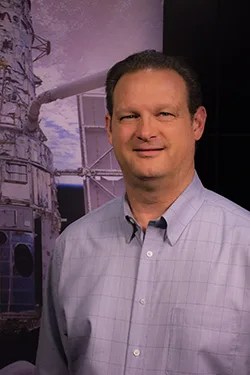
Dave Murphy
Lead Pointing Engineer
Breathtaking images of glittering expanses of stars, distant galaxies and glowing nebulas make it easy to forget something about the Hubble Space Telescope — it was built in the 1970s and 1980s. Technology has since far outpaced its original design.
But Hubble was built to adapt to those changes, with a design that allowed astronauts to swap out older components for more advanced versions. Among those older components were reel-to-reel tape recorders, used to store data that couldn’t be sent immediately to the ground.
Dave Murphy helped develop a solid-state recorder, similar to a big computer memory stick, that would replace Hubble’s tape recorders, as well as the plan to operate it on Hubble. His work on the project as a systems engineer culminated in the installation of Hubble’s first solid-state recorder during the telescope’s 1997 servicing mission, allowing the telescope to store 10 times more data than before. “That was a big help at the time, since the science data volume was going increase substantially with the new science instruments,” he recalled.
He would go on to lead the Data Management Subsystem team as it worked on a second solid-state recorder, installed on Hubble in 1999. “That recorder was different because we added an interface that allowed us to play back and record at the same time, so it increased the efficiency again,” Dave said. “It took a lot of development with different groups to come up with a system where we wouldn’t lose data by mixing records and playbacks.”
After that, Dave switched to a position working on the system used to point Hubble at its targets, which was more closely related to the aerospace engineering bachelor’s degree he’d earned in college and which let him better use his knowledge of physics. He took on his role with the Pointing Control Subsystem team as lead systems engineer in 2009.
Dave started working for Hubble directly out of college as an intern in 1990, after seeing a bulletin board post seeking interns for data processing at Goddard Space Flight Center. Growing up in Fulton, Maryland, he’d always been interested in planes and spacecraft. Difficulty with his grades during his senior year of high school led him to Howard Community College in Columbia, Maryland, where he spent time improving his academics before moving to the University of Maryland, Baltimore County. There he earned the credits in math, physics and chemistry that allowed him to transfer to the University of Maryland, College Park, which had the aerospace program that most interested him. “It took me awhile, but I got there.”
After being hired full-time for data processing following his internship, Dave applied for a flight controller position with Hubble. “It was really more of a monitoring position. We didn’t control much. We were more like the eyes and ears. We would report things to the systems engineers who would come in and try to fix the problems we were having.” The position would be the start of his lengthy career working on the telescope.
Much of Dave’s work involves Hubble’s gyroscopes, the devices that measure the speed at which Hubble is turning. Hubble has six gyroscopes on board: three in use and three as backups. Gyroscopes inevitably fail as they age, and Dave worked with the team that devises ways to use fewer gyroscopes as needed, extending the life of the devices. When problems occur with the gyros, Dave helps to come up with fixes — a challenging task that requires creative thinking. “They keep finding new ways to fail,” he joked.
With the help of his efforts, Hubble will be able to continue to do science even when it's eventually down to one gyroscope. But in the meantime, Dave works to keep the gyroscopes and other pieces of the long-lived telescope running in the best shape possible, assisting in the design of enhancements like an onboard software program that executes a running restart of a gyro if it stalls. “It does get intense at times,” he said. “But you work as a team and get the job done.”

